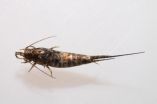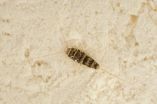(Press-News.org) This news release is available in German.
An insect's sense of smell is vital to its survival. Only if it can trace even tiny amounts of odor molecules is it is able to find food sources, communicate with conspecifics, or avoid enemies. According to scientists at the Max Planck Institute for Chemical Ecology in Jena, Germany, many proteins involved in the highly sensitive odor perception of insects emerged rather late in the evolutionary process. The very complex olfactory system of modern insects is therefore not an adaptation to a terrestrial environment when ancient insects migrated from water to land, but rather an adaptation that appeared when insects developed the ability to fly. The results were published in the Open Access Journal eLife (eLife, March 26, 2014, doi: 10.7554/elife.02115)
Many insect species employ three families of receptor proteins in order to perceive thousands of different environmental odors. Among them are the olfactory receptors. They form a functional complex with another protein, the so-called olfactory receptor co-receptor, which enables insects to smell the tiniest amounts of odor molecules in their environment very rapidly.
Crustaceans and insects share a common ancestor. Since crustaceans do not have olfactory receptors, previously scientists assumed that these receptors evolved as an adaptation of prehistoric insects to a terrestrial life. This hypothesis is also based on the assumption that for the ancestors of recent insects, the ability to detect odor molecules in the air rather than dissolved in water was of vital importance.
Early research on insect olfactory receptors focused entirely on insects with wings. Ewald Große-Wilde and Bill S. Hansson and their colleagues from the Max Planck Institute for Chemical Ecology in Jena, Germany, have now taken a closer look at the olfactory system of wingless insects, which − in evolutionary terms − are older than winged insects: the jumping bristletail Lepismachilis y-signata and the firebrat Thermobia domestica, which are both wingless, as well as the leaf insect Phyllium siccifolium, which is winged and was used as a control. As all three studied insect species emerged at different times in insect evolution, the scientists wanted to track the historical development of olfactory receptors.
Christine Mißbach, first author of the study, analyzed the active genes in the insect antennae where the olfactory receptors are located and describes her discovery this way: "Astonishingly, the firebrat, which is more closely related to flying insects, employs several co-receptors, while the odorant receptors themselves are absent."
However, the researchers did not find any evidence for an olfactory system which is based on odorant receptors in the most basal insect, the jumping bristletail.
"According to these findings, the receptor family which is important for olfaction in recent insects evolved long after the migration of insects from water to land," Ewald Große-Wilde summarizes. The researchers are convinced that the main olfactory receptors evolved independently of the co-receptor long after insects had adapted to terrestrial life. They hope that further analyses will reveal why some insect species have only co-receptors, no main receptors, and also clarify the function these co-receptors have on their own. [AO]
INFORMATION:Original Publication:
Missbach, C., Dweck, H., Vogel, H., Vilcinskas, A., Stensmyr, M. C., Hansson, B. S., Grosse-Wilde, E. (2014). Evolution of insect olfactory receptors. eLife, doi:10.7554/elife.02115.
http://elife.elifesciences.org/content/3/e02115
Further Information:
Dr. Ewald Große-Wilde, Max Planck Institute for Chemical Ecology, E-Mail grosse-wilde@ice.mpg.de
Contact and Picture Requests:
Angela Overmeyer M.A., Max Planck Institute for Chemical Ecology, Hans-Knöll-Str. 8, 07743 Jena, +49 3641 57-2110, overmeyer@ice.mpg.de
Download of high-resolution images via http://www.ice.mpg.de/ext/735.html
The first insects were not yet able to smell well
Odorant receptors of recent insects evolved long after insects migrated from water to land
2014-03-27
ELSE PRESS RELEASES FROM THIS DATE:
One gene, many tissues
2014-03-27
Genes are the "code" for building the biological elements that form an organism. The DNA that makes up genes contains the instructions to synthesise proteins, but it's wrong to think that, for a given gene, these instructions are always the same for all parts of the organisms. In actual fact, the gene varies depending on the tissue where it is located (cerebral cortex, cerebellum, olfactory epithelium, etc.); in particular, what varies is the point in the "string" of code at which protein synthesis starts. This complexity complicates the work of scientists considerably, ...
How size splits cells
2014-03-27
One of the scientists who revealed how plants "do maths" can now reveal how cells take measurements of size. Size is important to cells as it determines when they divide.
In a paper published in eLife, Professor Martin Howard from the John Innes Centre and colleagues from the US, Germany and Singapore discovered that cells measure their surface area using a particular protein, cdr2p. The finding challenges a previous model suggesting that another protein called pom1p senses a cell's length.
"Many cell types have been shown to reach a size threshold before they commit ...
Natural plant compounds may assist chemotherapy
2014-03-27
Auckland, New Zealand. 27 March 2014...Researchers at Plant & Food Research have identified plant compounds present in carrots and parsley that may one day support more effective delivery of chemotherapy treatments.
Scientists at Plant & Food Research, working together with researchers at The University of Auckland and the National Cancer Institute of The Netherlands, have discovered specific plant compounds able to inhibit transport mechanisms in the body that select what compounds are absorbed into the body,and eventually into cells. These same transport mechanisms ...
Smoke-free air policies seem to protect the heart
2014-03-27
WASHINGTON (March 27, 2014) — A new study on the impact of Michigan's statewide smoking ban adds to mounting evidence that policies prohibiting tobacco smoking in workplaces and other public spaces may substantially improve public health by reducing heart disease and death, according to research to be presented at the American College of Cardiology's 63rd Annual Scientific Session.
Studies on previous indoor smoking bans have consistently shown a major decrease in hospital admissions for heart attacks after smoke-free laws went into effect. Secondhand smoke exposure is ...
The heart responds differently to exercise in men vs. women
2014-03-27
WASHINGTON (March 27, 2014) — The formula for peak exercise heart rate that doctors have used for decades in tests to diagnose heart conditions may be flawed because it does not account for differences between men and women, according to research to be presented at the American College of Cardiology's 63rd Annual Scientific Session.
The simple formula of "220 minus age" has been widely used to calculate the maximum number of heart beats per minute a person can achieve. Many people use it to derive their target heart rate during a workout. Doctors use it to determine how ...
Cholesterol levels vary by season, get worse in colder months
2014-03-27
WASHINGTON (March 27, 2014) — Cholesterol levels fluctuate based on the time of year with more unfavorable lipid profiles seen in the colder months, a trend that may be driven by related behavior changes, according to research to be presented at the American College of Cardiology's 63rd Annual Scientific Session.
While previous studies have shown that heart attacks and heart-related deaths increase during the winter months, researchers at Johns Hopkins Ciccarone Center for the Prevention of Heart Disease were interested in finding out whether cholesterol parameters might ...
Mediterranean diet may lower risk of diabetes
2014-03-27
WASHINGTON (March 27, 2014) — Adoption of a Mediterranean diet is linked to a lower risk of diabetes, especially among people at high risk for cardiovascular disease, according to research to be presented at the American College of Cardiology's 63rd Annual Scientific Session.
Data from the first pooled analysis of studies evaluating the possible role of the Mediterranean diet on diabetes development show that adherence to this diet was associated with a 21 percent reduced risk of diabetes as compared to the control dietary groups. This reduced risk was even more pronounced ...
Marathon training could help the heart
2014-03-27
WASHINGTON (March 27, 2014) — Marathon training is associated with improved risk factors related to cardiovascular disease among middle-aged recreational male runners, suggesting that race preparation may be an effective strategy for reducing heart disease risk, according to research to be presented at the American College of Cardiology's 63rd Annual Scientific Session.
Over the last decade, marathon participation has risen steadily among middle-aged people seeking the reported health benefits of regular physical exercise. Some studies have shown that older men are significantly ...
More severe heart disease found in patients with vitamin D deficiency
2014-03-27
WASHINGTON (March 27, 2014) — Vitamin D deficiency is an independent risk factor for heart disease with lower levels of vitamin D being associated with a higher presence and severity of coronary artery disease, according to research to be presented at the American College of Cardiology's 63rd Annual Scientific Session.
A growing body of research shows that vitamin D may be beneficial in preventing heart disease. Several recent studies also support the idea that low levels of vitamin D are linked to an increased risk of heart disease; however, it is still not clear whether ...
Clusters of 'broken hearts' may be linked to massive natural disasters
2014-03-27
WASHINGTON (March 27, 2014) — Dramatic spikes in cases of Takotsubo cardiomyopathy, also called broken heart syndrome, were found in two states after major natural disasters, suggesting the stress of disasters as a likely trigger, according to research to be presented at the American College of Cardiology's 63rd Annual Scientific Session. Authors call for greater awareness among emergency department physicians and other first responders.
Takotsubo cardiomyopathy, or broken heart syndrome, is a disorder characterized by a temporary enlargement and weakening of the heart ...
LAST 30 PRESS RELEASES:
Numbers in our sights affect how we perceive space
SIMJ announces global collaborative book project in commemoration of its 75th anniversary
Air pollution exposure and birth weight
Obstructive sleep apnea risk and mental health conditions among older adults
How talking slows eye movements behind the wheel
The Ceramic Society of Japan’s Oxoate Ceramics Research Association launches new international book project
Heart-brain connection: international study reveals the role of the vagus nerve in keeping the heart young
Researchers identify Rb1 as a predictive biomarker for a new therapeutic strategy in some breast cancers
Survey reveals ethical gaps slowing AI adoption in pediatric surgery
Stimulant ADHD medications work differently than thought
AI overestimates how smart people are, according to HSE economists
HSE researchers create genome-wide map of quadruplexes
Scientists boost cell "powerhouses" to burn more calories
Automatic label checking: The missing step in making reliable medical AI
Low daily alcohol intake linked to 50% heightened mouth cancer risk in India
American Meteorological Society announces Rick Spinrad as 2026 President-Elect
Biomass-based carbon capture spotlighted in newly released global climate webinar recording
Illuminating invisible nano pollutants: advanced bioimaging tracks the full journey of emerging nanoscale contaminants in living systems
How does age affect recovery from spinal cord injury?
Novel AI tool offers prognosis for patients with head and neck cancer
Fathers’ microplastic exposure tied to their children’s metabolic problems
Research validates laboratory model for studying high-grade serous ovarian cancer
SIR 2026 delivers transformative breakthroughs in minimally invasive medicine to improve patient care
Stem Cell Reports most downloaded papers of 2025 highlight the breadth and impact of stem cell research
Oxford-led study estimates NHS spends around 3% of its primary and secondary care budget on the health impacts of heat and cold in England
A researcher’s long quest leads to a smart composite breakthrough
Urban wild bees act as “microbial sensors” of city health.
New study finds where you live affects recovery after a hip fracture
Forecasting the impact of fully automated vehicle adoption on US road traffic injuries
Alcohol-related hospitalizations from 2016 to 2022
[Press-News.org] The first insects were not yet able to smell wellOdorant receptors of recent insects evolved long after insects migrated from water to land


